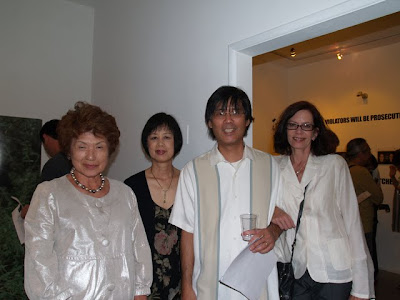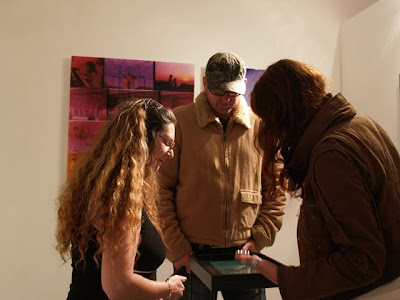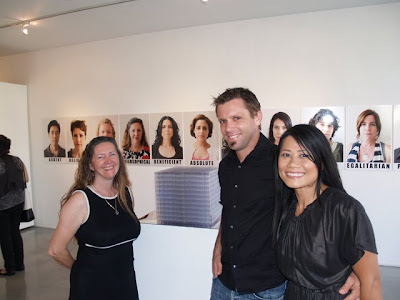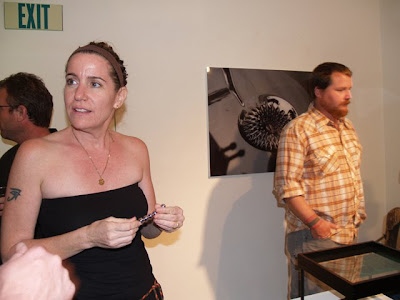THURSDAY, AUGUST 19, 2010
SEE THRU EXHIBITION OPENED 8.14.10 GALLERY 825 LOS ANGELES
Professor Shinsuke Shimojo of CalTech,
a world-renowned researcher and expert in field of vision,
perception and cognitive neuroscience inspired artists from LAAA/Gallery 825
to create new work reflecting scientific principals
exploring the intersection between photography, neuroscience and the arts.
Ann Marie Rousseau photographs Romann Weber for "Science and Surveillance"
Photo by Ginger Van Hook
SMALL GALLERY and MAIN GALLERY
Science and Surveillance
A.M.Rousseau
Description:
The work in this project plays off Shinsuke Shimojo’s studies on perception and the interplay of emotion, decision-making and consciousness.* Our eyes are constantly scanning our surroundings in rapid leaps, instantaneously accumulating information as they move several times per second, all without conscious effort or knowledge. Shimojo describes the “gaze cascade effect,” in which a subject's gaze between two objects under consideration gradually shifts to favor the object ultimately chosen. Research has indicated that these gaze cascades, also called orienting, are deeply involved in higher-level brain functions such as decision making.
In experiments asking subjects to compare two faces and label one as either attractive or unattractive, Shimojo discovered that the more that someone looks at a particular face, the more he or she wants to look at it, and consequently the more likely it becomes that the face will be labeled as “attractive.” This happens even before the viewer makes a conscious decision. His research also found that the participants' judgments of attractiveness versus unattractiveness could be manipulated by limiting the length of time they were allowed to look at a particular face. According to Shimojo, the unconscious, spontaneous movements of the eyes work in concert and affect what are presumed to be more deliberate cognitive tasks when making choices.
Various studies in cognitive and neuro sciences have demonstrated that images—of a face, for instance—and semantic contents such as verbal labels interact through various mechanisms in order to produce a stable and consistent interpretation of the image. In today’s modern surveillance society, labeling occurs in myriad ways, both benign and nefarious. This continual labeling has far broader scope and more serious consequences than ordinary judgments of "attractive" and "unattractive," but it is perhaps influenced by some of the same subliminal forces shown in Shimojo’s work.
The lineup of "perpetrators" in this installation shows faces with labels quite contrary to the presumed task of security surveillance, which aims to identify malefactors, terrorists, criminals, dangerous subjects and other potential wrongdoers. Instead these labels, which have been loosely extrapolated from the Buddhist tenets of the ten perfections, seek to discern those with traits most useful, beneficial, lasting and constructive for society. Although these labels are essentially positive, the viewer cannot help but approach them with a consciousness of what it is to be watched and labeled specifically, and an appreciation of the complex tensions inherent in labeling in general.
•“Gaze bias both reflects and influences preference,” Shinsuke Shimojo, Claudiu Simion, Eiko Shimojo, & Christian Scheier, Nature Neuroscience, Advance online publication, 9 November 2003; doi:10.1038/nn1150
Romann Weber
Marcie Kaufmann
Ginger Van Hook
Elizabeth Tobias
Krista Kahl
Mei Xian Qiu
Meg Madison
Siri Kaur
Ching Ching Cheng
Shana Mabari
Krista Kahl and Ann Marie Rousseau
Krista Kahl, Mei Xian Qiu and Ann Marie Rousseau
Krista Kahl and Ginger Van Hook during the installation
of Connection 1 and Connection 2. Photo by Ann Marie Rousseau
ASSEMBLE
Dori Atlantis, Ching-Ching Cheng, Meg Madison and Mei Xian Qiu
6' x 17' x 13' Digital Photographs, Plexiglass, Monofilament
Photo by Ann Marie Rousseau
Color Space
Ching-Ching Cheng
9"x9"x9" Urethane, Pigment Photo by Ann Marie Rousseau
Blue Volumetric
Yoichi Kawamura, Shana Mabari and Shinsuke Shimojo
42” x 42” x 42” Plexiglass Cube + Mixed Materials
Photo by Ann Marie Rousseau
Color Space
Ching-Ching Cheng
9"x9"x9" Urethane, Pigment
Photo by Ginger Van Hook
Blue Volumetric
Yoichi Kawamura, Shana Mabari and Shinsuke Shimojo
42” x 42” x 42” Plexiglass Cube + Mixed Materials (Photo by Ginger Van Hook)
Optic Chasm
Mei Xian Qiu
Dimensions Varied – Plexiglass Cube, Water,
Used Motor Oil, Projector, Tempera.
(Photo by Ginger Van Hook)
Luke Van Hook installs the "BRAIN" 8.14.10 Photo by Ginger Van Hook
The "Brain" by Luke Van Hook. Photo by Ginger Van Hook
GALLERY WINDOW
Connections 1, Connections 2
Krista Kahl
48”x 60" silver gelatin prints with india ink.
Price: $3200 ea.
Magnetic vinyl "Neurons" approx. 8x10" $40 each. (16 total) Can be purchased individually or in sets.
Description:
Our urban environment is a by-product of our brains, our perceptions and ultimately our imagination. In this installation I share a glimpse of how I interpret the inner and outer connections of our brain to our environment, from micro to macro. Having an avid interest in astronomy, electricity and the inner workings of the mind I found it interesting how they are all intertwined. This idea began while I was driving around the city and trying to photograph the sky. I couldn't help but notice how the wires always seemed to get in the way. I started to obsess about them. The more I looked, the more I saw, until finally, instead of fighting to get rid of them I decided to include them in my photographs. I began to contemplate what exactly was going through all those wires.... visually, they are just black lines. But inside, it was obvious there was a whole other invisible world going on - a secret little communicative world of energy, electricity, sound and life. I realized this world was parallel to the inner workings of our brain, whether it is electrical impulses being transferred to our buildings and homes or electrical impulses being transferred through the neurons and synapses in our brain - it is all basically the same, depending on how you look at it.
I use black and white film and chemistry to capture the images, then draw lines extending onto the paper landscape and leave it to the viewer to imagine where these lines end. In the window, whimsical Neuron Creatures float through space; each one has it's own little life and is a part of the bigger whole.
SOUTH GALLERY
ASSEMBLE
Dori Atlantis, Ching-Ching Cheng, Meg Madison and Mei Xian Qiu
6' x 17' x 13' Digital Photographs, Plexiglass, Monofilament
Price: $4,000 total installation, photos available individually
Description:
ASSEMBLE explores the intersection of vision and perception through an installation that mimics the way congenitally blind people process information. Four artists have collaborated to dissect one photographic image into parts, fragments, slices, and pieces. The resulting installation of images attempts to simulate the way a blind person must confront all experiences, in a detailed piece-by-piece examination to understand an object, person or environment. ASSEMBLE also investigates the hierarchy of perception - by breaking apart one iconic photograph into bits and pieces leaving much of the final details to the mind of the viewer.
SMALL GALLERY
Science and Surveillance
A.M.Rousseau
Size, Medium
Price:
Description:
The work in this project plays off Shinsuke Shimojo’s studies on perception and the interplay of emotion, decision-making and consciousness.* Our eyes are constantly scanning our surroundings in rapid leaps, instantaneously accumulating information as they move several times per second, all without conscious effort or knowledge. Shimojo describes the “gaze cascade effect,” in which a subject's gaze between two objects under consideration gradually shifts to favor the object ultimately chosen. Research has indicated that these gaze cascades, also called orienting, are deeply involved in higher-level brain functions such as decision making.
In experiments asking subjects to compare two faces and label one as either attractive or unattractive, Shimojo discovered that the more that someone looks at a particular face, the more he or she wants to look at it, and consequently the more likely it becomes that the face will be labeled as “attractive.” This happens even before the viewer makes a conscious decision. His research also found that the participants' judgments of attractiveness versus unattractiveness could be manipulated by limiting the length of time they were allowed to look at a particular face. According to Shimojo, the unconscious, spontaneous movements of the eyes work in concert and affect what are presumed to be more deliberate cognitive tasks when making choices.
Various studies in cognitive and neuro sciences have demonstrated that images—of a face, for instance—and semantic contents such as verbal labelsinteract through various mechanisms in order to produce a stable and consistent interpretation of the image. In today’s modern surveillance society, labeling occurs in myriad ways, both benign and nefarious. This continual labeling has far broader scope and more serious consequences than ordinary judgments of "attractive" and "unattractive," but it is perhaps influenced by some of the same subliminal forces shown in Shimojo’s work.
The lineup of "perpetrators" in this installation shows faces with labels quite contrary to the presumed task of security surveillance, which aims to identify malefactors, terrorists, criminals, dangerous subjects and other potential wrongdoers. Instead these labels, which have been loosely extrapolated from the Buddhist tenets of the ten perfections, seek to discern those with traits most useful, beneficial, lasting and constructive for society. Although these labels are essentially positive, the viewer cannot help but approach them with a consciousness of what it is to be watched and labeled specifically, and an appreciation of the complex tensions inherent in labeling in general.
•“Gaze bias both reflects and influences preference,” Shinsuke Shimojo, Claudiu Simion, Eiko Shimojo, & Christian Scheier, Nature Neuroscience, Advance online publication, 9 November 2003; doi:10.1038/nn1150
BACK GALLERY – WURDEMANN ROOM
Blue Volumetric
Yoichi Kawamura, Shana Mabari and Shinsuke Shimojo
42” x 42” x 42” Plexiglass Cube + Mixed Materials
Price: $20,000
Description:
Throughout history, art and science have had much in common. Both disciplines tackle a subject in depth and with great curiosity. One uses methodic measures and recording of results, and the other uses internal intuitive reasoning to create artwork. ‘Blue Volumetric’ is a collaborative piece among a scientist/artist and two artists immersing themselves into the Science of Vision and using art to record that work.
The piece attempts to give color another dimension. By definition, color has three properties: hue, saturation and brightness. Even though volumetric (3D) color is everywhere in the natural environment, such as in the sky or the water, it has been neglected relative to surface (2D) color in perceptual psychology and cognitive neuroscience. This piece introduces volumetric, as well as temporal qualities to this unique “qualia”(a philosophical term for subjective quality) of the hue. Steam is enclosed to give blue light space, and at the same time, the steam is constantly changing from steam to water and back to steam. The piece is also meant to demonstrate sequential and simultaneous color contrast phenomena.
Brain Projector
Luke and Ginger Van Hook
24” x 24” x 24” Mixed Media
Price: $2500
Description:
Based on the traditional Marawa Doro Japanese Rotating Lantern, this light and space installation investigates the visual cortex as a metaphor for how the brain processes information.
Optic Chasm
Mei Xian Qiu
Dimensions Varied – Plexiglass Cube, Water, Used Motor Oil, Projector, Tempera.
Price: $ 4,200
Description:
This work is about optic illusion, the difference between what we believe is in front of us and what is actually there as a physical object. I am interested in human perception as defined by light, shadow, and belief. A thick slick of black oil from a '75 Chevy on a glowing liquid cube. A video projection that appears to move in, through, and around the cube. A serious comedy of optics, and ecological and fundamental opposites.
MAIN GALLERY
The New Zodiac
Grid of Politicians (Untitled Politician #1-6), Grid of Bunnies (Untitled Bunny #1-6)
Siri Kaur with Romann Weber and Daw-an Wu
13 x 19’’ Pigment Prints, 2010. Edition of 5.
Price: $400 each or $2000/ grid
Description:
The images were made using eye tracking software in the Shimojo laboratory at CalTech, where each image was viewed for a total of five seconds by the three collaborators. The parts of the images that are visible represent the course of the viewers’ eye movements. It’s as if their eyes became a razor, scraping out the relevant sections of each picture, charting a course of relevancy. The portions represented by the solid color and black areas reveal the portions of the pictures the viewers’ eyes neglected. Thus the images become visible maps of the way humans see the world. In five seconds or less, eyes, mouths, breasts, and flesh are what we look at first.
These cultural icons, both the politicians and pinups, were chosen by the artist for nostalgic reasons, because of their influence over her during her formative years, for better or for worse. The color palette of “Politicians”, borrowed from popular design palettes of 1960’s and 1970’s, displaces them from their typical flag backdrops; one of each color is arbitrarily assigned to each politician. The deep black ground of the “Bunnies” removes their fleshy bodies from the usual setting of sugary boudoirs.
Color Space
Ching-Ching Cheng
9"x9"x9" Urethane, Pigment
Price: $2500
Description:
Colors are inside our brain; outside is colorless because the physical environment contains only light waves. Colors that we perceive are determined not just by physical properties of light (i.e. wavelength and energy), but also physiological optics of the eye and neural processing. So any color that our eyes receive is a perception of color, as well as a psychological color. This installation aims to visualize perceptions of colors in space, which have three dimensions: color tone (first dimension), lightness (second dimension), and saturation (third dimension).
The Opposite of Love
Mei Xian Qiu
26.5 x 36.5, Lambda print, Edition of 10
Price: $850 ea.
Description:
This work explores ambiguity and intensities of emotion and intent. How do we visually perceive love, loss, and malcontent? A woman looks longingly or in anger? Two images of the same woman, different object in hand, one flowers, the other a gun. Her expression is the same, or is it?
MAIN GALLERY continued
Man,Woman and Revolver
Mei Xian Qiu and Meg Madison
10” x 28” Framed Chromagenic Print
Price: $
Description:
This exploration replaces incendiary primary imagery with words, challenging the viewer to create a complete visual context. I am interested with what is not in the frame as much as what is in it. There exists for the viewer a combination of a self created visual picture from the words, what something "should" look like, subliminally borne from memory and enculturation, in the same way we create a visual memory from reading a novel, with the remaining portion of photograph (where the visual information is readily divulged).
See Thru
Marcie Kaufman
Archival Digital Prints, 2010
Price: $600
Can you trust what you feel?
Marcie Kaufman
Archival Digital Print, 2010
Price: $450
Electric
Marcie Kaufman and Krista Kahl
Archival Digital Print, 2010
Price: $450
Crossing
Marcie Kaufman and Krista Kahl
Archival Digital Print, 2010
Price: $450
Description:
Marcie Kaufman is responding to Professor Shinsuke Shimojo's work on tactile cognition--how the brain "reads" touch on the skin. At different places and positions of the body, the brain reads touch in mirror reverse. She created photographs that make visible Shimojo's findings of invisible cognitive interpretation by drawing directly on the body, and developed poetic connections with the science behind the work.
MAIN GALLERY continued
Nostalgia
Shinsuke Shimojo & Shana Mabari
61”H x 10.5”W x 16.5”D, Mixed media (wood, brushed aluminum, goggles, flash bulb, battery).
Price: $12,000.
Description:
Where does memory exist? In the mind, the brain, or the world? We do not have a definite answer, but it should exist somewhere in our reality because otherwise, how could we sometimes be smiling or crying over a very personal mnemonic image which is years or even decades old? Memory is often tightly connected with emotional experience, as demonstrated in special phenomena such as “flash-bulb memory” phenomenon. Emotion helps to consolidate memory as well as to trigger and distort. This installation aims to “replay” such long-term dynamics of memory distortion, fading and reviving, within a frame of several seconds in flash-initiated afterimage.
Brain
Luke and Ginger Van Hook
12”L x 12”W x 12” Polycarbonate, LED Diodes, batteries, mirrored plexiglass
Price: $2500.
Description:
Transparent abstract sculpture performance that mimics the human brain. During this exhibition the “Brain” Sculpture will be born, mature, fade then die. This occurs as the LED lights burn the brightest at it’s birth, then begin to decrease in illumination as it ages, and eventually ceases to shine, culminating in its final electronic death. A birth notice is prepared in a local newspaper and an obituary notice will be recorded when it ceases its life cycle. Expected life cycle = 5 days.
Ferromagnetic Fields-LIGHT and Ferromagnetic Fields-DARK
Luke and Ginger Van Hook
30” x 40” Photographic Digital C-Print, framed in Plexiglass
Price: $3000 ea.
Description:
Ferrofluid is a liquid that becomes strongly magnetized in the presence of a magnetic field and is composed of nanoscaled particals of magnetite or hermatite or another compound containing iron. Invented in the late 1960s in NASA’S Apollo Program (National Aeronautics and Space Administration) ferrofluids are well known for their use in forming liquid seals and in electronic devices for computers, audiovisual equipment, some industrial applications and in medical and scientific research. Ferrofluids appear as a black fluid. They are prepared by dissolving nanoscale ferromagnetic particles in a solvent such as water or oil and remain strongly magnetic even in a fluid condition. Abstract shapes are created by the rising of spikes under a magnetic field that is controlled by electromagnets from below the surface. During a re-creation of this experiment, photographs reveal a battery operated red colored LED diode is swallowed up by the ferrofluids to form spiked shapes in mysterious configurations.
MAIN GALLERY continued
Electromagnetic Fields-First Steps and Electromagnetic Fields of Memory
Luke and Ginger Van Hook
22” x 42” Photography Darkroom C-Print, framed in plexiglass
33” x 42” Photography Darkroom C-Print, Collage framed in plexiglass
Price: $3000 ea
Description:
The memories in our brains are invisible to the outside observer. At best, the way we have of sharing these memories is through the medium of photography. All brain activity is based on a series of electrical impulses within a neuron, which then communicate neurochemically beyond synapses, much like our corporate culture has erected Power Towers to carry our energy and communications throughout the world. Vague perceptions, faded remembrances and filtered consciousness runs through these collages of images examining the relationship of electromagnetism to our brains, our bodies and our environment.
Streams of power lines, telephone cables, satellite transmission dishes, cell phone towers as well as electronics both inside and outside our homes run along our landscapes like the streams of consciousness run through our thoughts. Some images of memories are clear and poignant. Some images are obscured and reside in the outer edges of our consciousness; not revealing themselves yet providing the hint of a feeling one can never fully grasp like a dream that has evaporated upon wakening.
[Growing up in the late 1960’s, my sister Else and I lived in a home along Southern Blvd. and Dudlext Street in Southgate, California where rows and rows of High Voltage Power Line Towers dotted the landscape like dominos. These structures of omnipotent architectural beauty towering over our childhood, made me feel like wanting to climb up the triangular bars like the limbs of trees, but our parents warned us to stay away. These images reveal new layers of filters to my memories as we investigate the invisible powers of low-level frequency electromagnetic fields (EMF’s) and their alleged associations.]
(Ginger Van Hook, artist reflections)
Revealing the Invisible
Luke and Ginger Van Hook
15”L x 12”W x 8.5”H, Magnetic Viewing Film in glass, aluminum frame. Interactive with cell phones
Price: $600
Description:
Magnetic Viewing Film is used to show stationary or slowly-changing magnetic fields; it reveals their location and direction. It is a dark green translucent thin flexible sheet, coated with micro-capsules containing nickel flakes suspended in oil. When the “receiver” end of a cell phone is applied to the magnetic viewing film, it reveals exactly where the magnetic field is located. During this exhibition, the gallery visitor is able to interact with the art by “drawing” with their cell phones, exposing the invisible changing magnetic fields.






















































